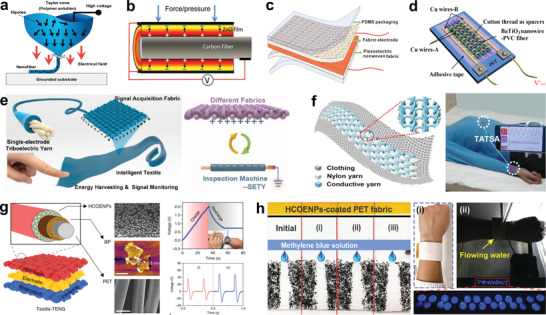Figure 18.

Piezo‐/triboelectric self‐powered fibers/fabrics. a) A direct‐written PVDF piezoelectric fiber. Reproduced with permission.[ 324 ] Copyright 2010, American Chemical Society. b) Carbon fiber/ZnO nanostructures fiber PENG. Reproduced with permission.[ 325 ] Copyright 2011, Wiley‐VCH. c) A PVDF‐NaNbO3 nonwoven fabric‐based PENG. Reproduced with permission.[ 326 ] Copyright 2013, Royal Society of Chemistry. d) A fully woven PENG based on BaTiO3/PVC fiber. Reproduced with permission.[ 327 ] Copyright 2015, Elsevier. e) A continuous triboelectric yarn based on PVDF/PAN nanofibers. Reproduced with permission.[ 328 ] Copyright 2020, American Chemical Society. f) A washable triboelectric all‐textile sensor for arterial pulse waves and respiratory monitoring. Reproduced with permission.[ 329 ] Copyright 2020, The Authors, published by American Association for the Advancement of Science (AAAS). Reprinted/adapted from ref. [ 329 ]. © The Authors, some rights reserved; exclusive licensee American Association for the Advancement of Science. Distributed under a Creative Commons Attribution NonCommercial License 4.0 (CC BY‐NC) http://creativecommons.org/licenses/by‐nc/4.0/. g) A skin‐actuated sandwiched all‐fabric TENG with high sensitivity for both voluntary and involuntary contacts with human skin. Reproduced under the terms of the CC‐BY Creative Commons Attribution 4.0 International License (https://creativecommons.org/licenses/by/4.0/).[ 330 ] Copyright 2018, The Authors, published by Springer Nature. h) A wearable all‐fabric TENG with capability for moisture screening and water energy harvesting. Reproduced with permission.[ 331 ] Copyright 2017, Wiley‐VCH.
